Inspired by Ukraine war, Taiwan launches drone blitz to counter China


TAIPEI - In the summer of 2022, just months after Russia invaded Ukraine, Taiwan's president gathered senior officials from her ruling party in downtown Taipei. On the agenda: How was Ukraine, in its war with Russia, successfully offsetting the advantages of a much more powerful foe?
President Tsai Ing-wen was given an internal 77-page briefing report via PowerPoint. It had a clear answer: Drones.
"Since the war began, Ukraine, which was previously considered as lacking air supremacy, cleverly used drones to create its own partial air supremacy," the presentation stated.
For Taiwan, though, the report painted a darker picture: The island lagged dangerously behind its far more powerful rival, China, in arming itself with aerial drones - and needed a crash programme to close the gap.
"We are far outnumbered," said the report, a copy of which was reviewed by Reuters.
The drone gap is stark. Taiwan currently has four drone types at its disposal and a fleet size of just "hundreds", according to two people with direct knowledge of the matter and a separate internal security report.
Across the narrow Taiwan Strait, China's military, the People's Liberation Army, has an arsenal of more than 50 different drone types that is estimated to run into the tens of thousands, according to defence analysts and a Reuters examination of Chinese military manufacturers and reports in Chinese state media. These drones range from jet-powered, long range surveillance aircraft to small quadcopters deployed by ground troops.
Clearly outmatched, Ms Tsai "pressed the button" on the creation of a strategic plan to close the gap, said a person who attended a series of meetings in which the drone strategy was forged. Under the "Drone National Team" programme, Taiwan is recruiting the island's commercial drone makers and aviation and aerospace firms in a joint effort with the military to fast-track the building of a self-sufficient drone supply chain.
"We need to quickly catch up, with thousands of drones," aerospace entrepreneur Max Lo, the coordinator of the drone effort, told Reuters in an interview. "We are trying our best to develop drones with commercial specifications for military use. We hope to quickly build up our capacity based on our existing technology so that we can be like Ukraine."
The aim, according to a government planning document reviewed by Reuters, is to build more than 3,200 military drones by mid-2024. These will include mini-drones that weigh less than 2kg as well as larger surveillance craft with a range of 150km.
To accelerate production, the government is for the first time enlisting private companies in the research and development phase of a weapons programme. At least nine private firms have joined the effort.
Thunder Tiger Group, best known for making radio-controlled model aircraft for leisure and commercial use, is typical of the type of companies recruited by the government. Participants have expertise ranging from aviation to telecommunications to the production of electronic components for applications like Global Positioning System (GPS) positioning.
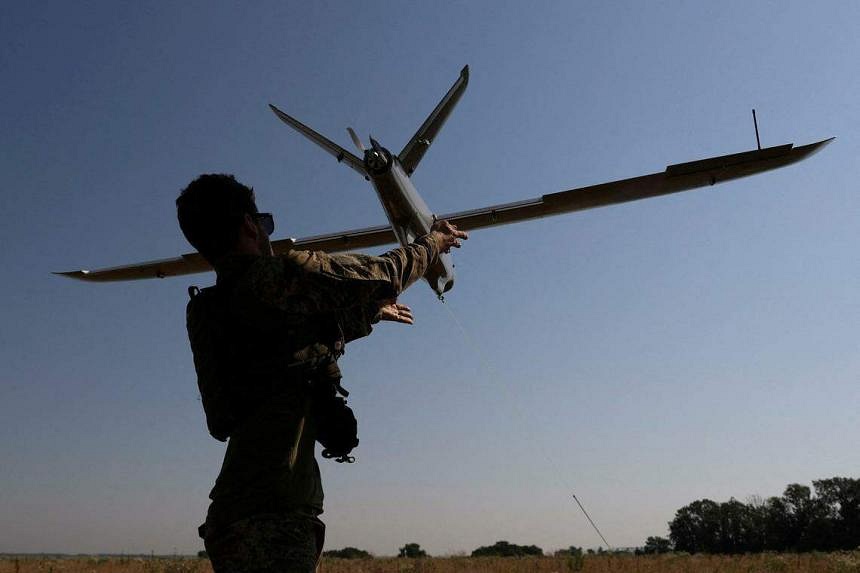
Mr Hawk Yang, the head of Thunder Tiger's R&D department, told Reuters his firm is now developing drones for Taiwan's military, including pilotless ship- or land-based surveillance helicopters with 4m-long rotors that have a range of 400km and can stay airborne for up to six hours.
His company, Mr Yang said, was recruited by defence ministry officials last year to turn commercial drones into craft that also have a military use.
"One small drone could blow up a tank that is worth tens of millions," he said, underscoring how rapidly modern warfare is changing with the rise of asymmetrical weapons - cheap, small arms that can offset big, expensive systems.
The Russia-Ukraine war has given Taiwan "great inspiration", Ms Tsai's office said in response to questions from Reuters. "In Russia's invasion of Ukraine, the entire world saw the importance of drones."
"For future generations, drones will play a very important role in both civilian and military applications," the president's office said. "For a country with advanced industries, Taiwan cannot be absent."
[[nid:621405]]
Taiwan's bid to mass produce drones is part of an intensifying military rivalry that is dividing Asia, setting off a sprint to harness emerging technologies with the potential to deliver a decisive boost in firepower. On one side are the US and its allies, including Taiwan, Australia, Japan and South Korea, who want to preserve American dominance in the region. On the other is an increasingly assertive China, determined to gain control over the democratically governed island and displace America as the leading regional power.
In this high-tech arms race, military and civilian researchers from both sides are scrambling to seize the lead across a swathe of fields, including artificial intelligence, autonomous weapons, advanced semiconductors, hypersonic flight, quantum computing and cyber warfare.
China's ruling Communist Party says Taiwan is an inalienable part of China and refuses to rule out force to bring the island under its control. Ms Tsai says Taiwan is already an independent country, formally called the Republic of China, and has vowed to defend its freedom and democracy. The US, bound by US law to provide Taiwan with the means to defend itself, has long followed a policy of "strategic ambiguity" on whether it would intervene militarily in the event of a Chinese attack. US President Joe Biden, however, has said that US forces would defend Taiwan in the event of an invasion.
In response to questions for this report, China's foreign ministry said the "Taiwan authorities' attempts to 'reject reunification with force' and 'seek independence with foreigners' is certain to fail." China's defence ministry and Taiwan Affairs Office did not respond to questions.
The US Department of Defence and White House did not respond to questions for this report.
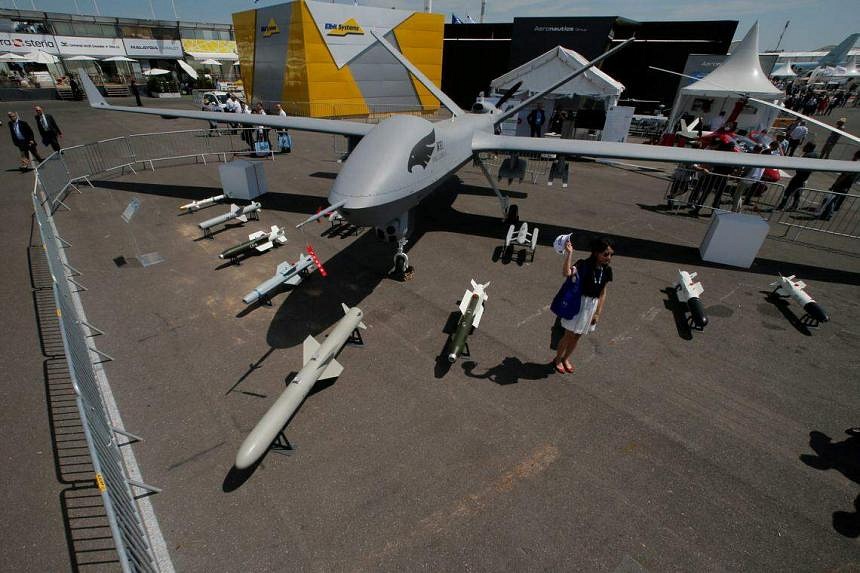
As China presses its claim to Taiwan, it has increasingly deployed drones as part of a campaign of grey-zone warfare - an almost daily series of intimidating air and surface operations that it has been waging around the island in an effort to test and wear down Taiwan's defences. In late April, the defence ministry in Taipei tracked a Chinese combat drone, the TB-001 Twin-Tailed Scorpion, as the craft completed the first known "encirclement" by a drone of Taiwan.
"China is intimidating Taiwan verbally and militarily," Ms Tsai's office said in its statement. " 'The more provocative the enemy, the more calm we need to be.' We won't give the other side any inappropriate excuse to trigger a conflict." Taiwan, it added, would "take necessary and forceful action" to defend its airspace.
Taiwan's inability to counter China's drone arsenal was on dramatic display in August last year, when the outlying island of Kinmen, controlled by Taiwan and located less than two km from the Chinese coastline at its closest point, was buzzed by Chinese civilian drones. A video clip first circulated on Chinese social media and later picked up by Taiwanese media showed two soldiers throwing stones at a drone that flew near their guard post.
Social media posts in Taiwan calling the incident a "national humiliation" got wide pickup in local press reports. Taiwan's defence ministry said in response to Reuters' questions that anti-drone jamming technology had since been deployed on its offshore islands.
😭 I can see why Taiwan want to spend more on defence tbf…
— PiQ (@PriapusIQ) August 25, 2022
The Taiwanese military recently tried to shoot down a Chinese drone with stones, which was photographing their positions in the Kinmen Archipelago.pic.twitter.com/2YEhuBK4xm
As part of the plan to close the drone gap, Ms Tsai last year ordered an assessment of Taiwan's drone industry, according to the two people with direct knowledge of the matter. The study included the sourcing of industrial materials and identifying the types of drones that would suit Taiwan's geography and military objectives. Ms Tsai wanted to know what Taiwan needed to do to develop what military planners call a "kill chain" for drones, in which targets are identified, tracked and then destroyed, said one of the people, a senior official familiar with Taiwan's security planning.
Mr Lo, the coordinator of the drone project, said he delivered the PowerPoint presentation to Ms Tsai in June last year.
The presentation noted Ukraine had used drones to conduct "asymmetrical warfare" and surprise attacks. It advised that Taiwan aim to become a major exporter of drone components and an R&D centre for this technology in Asia, with the government coordinating efforts. Taiwan should accelerate mass production of a range of military drones to boost self-reliance in the struggle with Beijing, it concluded.
Mr Lo told Reuters the island must build up a production line so it won't have to "cry piteously for help from others" if it comes under attack. And it must avoid relying on the so-called "red supply chain" - components sourced from China.
[[nid:600573]]
Ms Tsai has thrown her weight behind a drone plan that appears to conform with advice from Washington and senior Taiwanese military thinkers who propose an asymmetrical strategy. According to this thinking, Taiwan should bristle with big numbers of smaller but mobile and lethal weapons systems to deter China rather than acquire a small number of big-ticket weapons that would be vulnerable to attack, turning the island into what strategists call a "porcupine".
The US, Taiwan's main ally, has the world's most advanced military drones, say defence analysts. This includes an arsenal of more than 11,000 of these aircraft in service with the army, air force, navy and marines, according to the Pentagon. US drones range in size from two kg, hand-launched drones to 14,500kg long range surveillance drones. US allies Japan, Australia and South Korea also field aerial drones in their forces.
"The US military currently has the world's largest and most sophisticated drone fleet, with the rest of the world only beginning to catch up," the Teal Group, a defence and aerospace research firm, wrote in a 2022 and 2023 report.
In the event of a war over Taiwan, however, US drones would need to be dispatched from outside the conflict zone were the Americans to step in. There are no US or allied combat forces stationed on the island, so Taiwan would have to rely on its domestic fleet, at least in the early stages of an attack or invasion, according to military analysts interviewed by Reuters. Longer-range US and allied strike and surveillance drones could be deployed from bases in Japan and the Pacific if Washington and its allies decided to intervene in a conflict, they said.
And China is catching up.
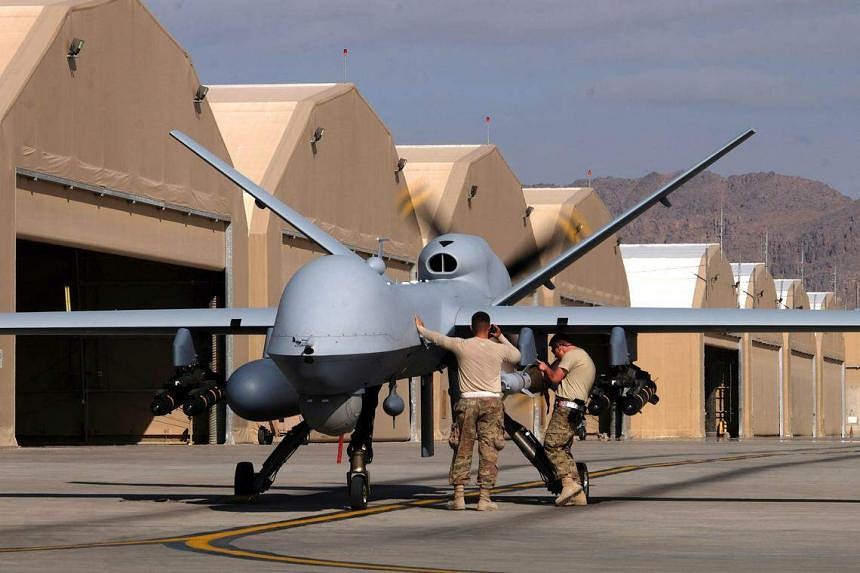
Dr Tai Ming Cheung, an expert on the Chinese military at the University of California San Diego, said that while the US maintains an advantage in drone capability, China has become more competitive because of the country's high degree of commercial-military fusion.
"The drone ecosystem in China involves a lot of companies in that space," Dr Cheung said. "So it's competitive, and drones are one of the areas where they've been very strong in exports."
A milestone moment came last August, with tensions running high as People's Liberation Army (PLA) warships and aircraft threatened the island just after a visit to Taiwan by former US House of Representatives Speaker Nancy Pelosi. That month, the Taiwanese leader opened a new drone R&D centre in the southern city of Chiayi.
"Facing the ever-changing geopolitical scene, Taiwan is also working hard to boost defence self-sufficiency," Ms Tsai said at the opening ceremony. "Under the goal of building our own military planes and submarines, the drone industry will be our focus."
In Ukraine, both sides have relied heavily on a broad range of drones for reconnaissance, surveillance and striking targets. Even rudimentary adaptations allowing mass-market consumer drones to drop grenades and mortar rounds have become deadly threats to tanks, artillery, troops and supply dumps, according to military experts and footage of these strikes widely circulated on social media.
Airborne munitions have prowled deep into both sides' rear areas, searching for targets as they loiter before launching deadly attacks. The frontlines have become "saturated" with drones, which have been used to improve battlefield awareness without risking loss of life for the operators, according to a November report from the Washington-based Centre for Strategic & International Studies. Ukraine and Russia have also deployed counter-drone technology, primarily electronic jamming and radar-controlled anti-drone guns and missiles, according to the report.
These measures have led to heavy equipment losses. Ukraine is now losing about 10,000 drones a month, according to a May report on the conflict from the Royal United Services Institute, a London-based defence research body. One lesson for foreign militaries studying the conflict is that drones should be plentiful and cheap, according to military experts.
Unlike Taiwan, China began mass-producing unmanned aircraft long before the Ukraine conflict. The PLA drone development programme began in the 1960s, when China developed the Chang Kong-1 (Vast Sky), a radio-controlled unmanned target aircraft adapted from earlier Soviet-supplied models.
The impetus for drone development comes from the top. At the 20th Party Congress in October, Chinese President Xi Jinping said Beijing would accelerate the "development of unmanned, intelligent combat capabilities".
Mr Xi began a major modernisation of the PLA after taking power over a decade ago. Hundreds of technology experts, including specialists in Artificial Intelligence (AI), were recruited to the military, according to University of California San Diego (UCSD) analyst Cheung. This has led to advances in drones as well as fighter jets, missiles and satellites.
"Xi Jinping very much sides with these young Turks, these techno-centric young folks," Dr Cheung said.
Today, China has virtually cornered the global commercial drone market, accounting for an estimated 80 per cent of sales, according to some industry estimates. This is a key advantage for the PLA, which can draw on this vast commercial drone industry for technical assistance, equipment suppliers and off-the-shelf models.
"In some respects, the Chinese military has advanced more quickly than the US military in adopting and experimenting with drones, and really leveraging commercial technologies and enterprises to explore a wide range of designs and possibilities," Ms Elsa Kania, a senior fellow at the Centre for a New American Security and a specialist on Chinese military technology, told Reuters.
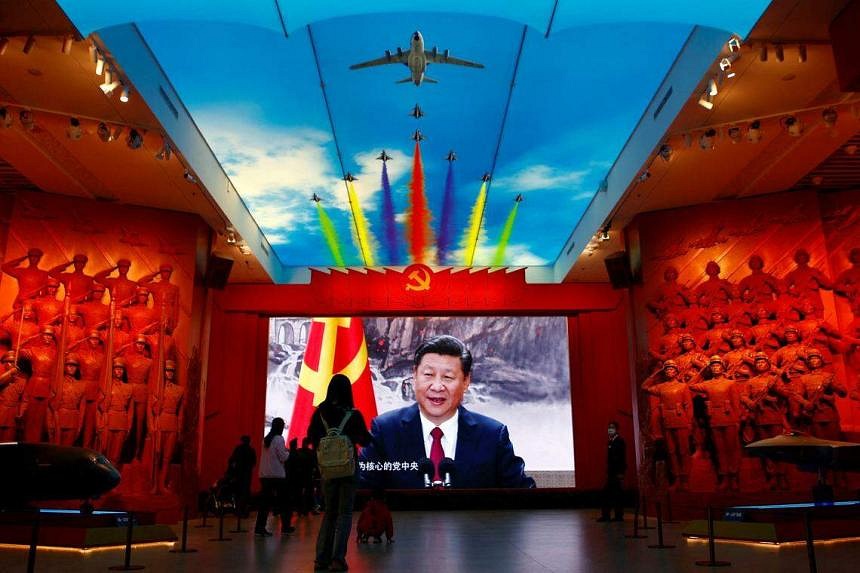
Still, there is little public information about the contribution drones now make to PLA operations. China's Ministry of Defence has never released figures on the size of its drone fleet. In a 2015 report, the US Department of Defence cited estimates that the PLA would have manufactured upwards of 40,000 drones by the end of 2023. In its annual report on China's military power, the Pentagon last year said the PLA is now deploying "ever more sophisticated" aerial drones.
One focus for the Chinese military is the potential launch of "drone swarms" - large numbers of drones powered by artificial intelligence and acting in concert as they attack targets. AI would allow these swarms to fly without the need for humans to control all aspects of their flight, threatening to overwhelm a potential enemy.
Six recent research papers by PLA-linked academic institutions and think tanks were specifically on "drone swarms". A dozen more papers reviewed by Reuters covered other drone warfare topics, ranging from the use of drones in "island combat" to the deployment of drones from warships.
Taiwan is rarely mentioned by name in these papers. But military observers say China would likely deploy large numbers of drones, including swarms, to target military and civilian infrastructure in the event Beijing launched a broad strike against the island.
"Drone swarm technology is a kind of game-changing disruptive technology in war," wrote three researchers at the Air Force Aviation University in Changchun in a 2022 research paper.
"Drone swarm operations are now recognised as a better way to deal with conflicts in the Taiwan Strait," the paper said. The researchers noted, however, that the US military retains "absolute dominance" in the research and development of drone swarms.
While arming the PLA, China's drone makers have also captured a growing share of the international military market. At China's pre-eminent showcase for cutting-edge weapons, the Zhuhai air show, Beijing unveiled its latest pilotless systems last November, including its most advanced combat and reconnaissance drone: The Wing Loong Three. The intercontinental drone has a 10,000km range, according to Chinese media reports. Also on display were swarm drone systems and anti-drone defences.
[[nid:627685]]
In a conflict with Taiwan, China's high-altitude drones could be deployed to gather intelligence on the island's mobile missile batteries and other assets, according to Dr Shu Hsiao-huang, a researcher at Taiwan's top military think tank, the Institute for National Defence and Security Research. For air and sea supremacy, the PLA could then deploy tactical drones such as the Twin-Tailed Scorpion to track, target and destroy Taiwan's mobile and land-based missile launchers, Dr Shu said.
China could also turn its retired fighter jets into suicide drones that could fly into Taiwanese airspace and "consume" the island's air defence missiles by drawing fire. "If they are taken down, it's not a great loss" for China, Dr Shu said.
Taiwan's drone campaign has been embraced by firms with an array of products in the pipeline, leveraging some of the island's existing high-tech talent pool and infrastructure. The civilian companies enlisted in the initiative have been tasked with designing and mass-producing at least six drone types as well as anti-drone systems, alongside six other new drone types under development at the Taiwan military's top defence R&D arm, the National Chung-Shan Institute of Science and Technology.
The unmanned surveillance helicopter being developed by Thunder Tiger Group is scheduled to go into production next year, according to general manager Gene Su. So is a small, two kg reconnaissance drone for use by ground troops.
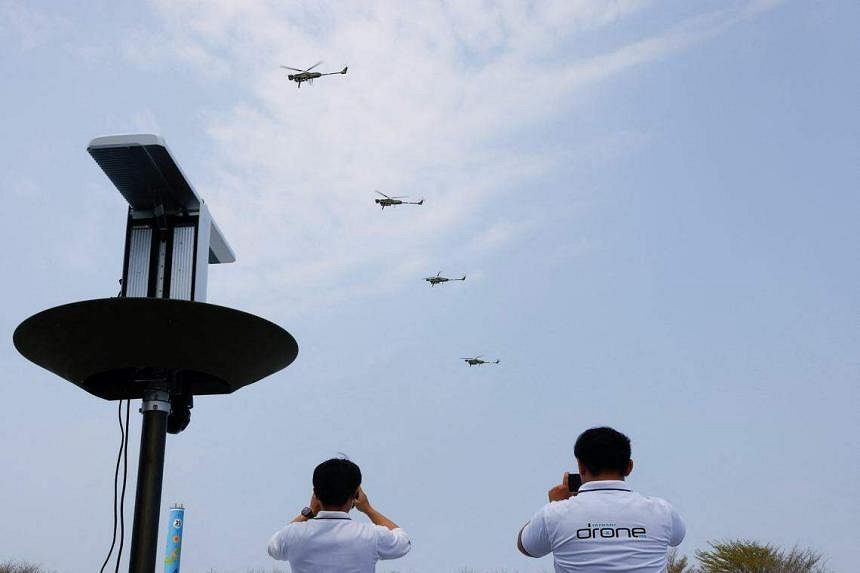
Taiwan's tech sector can supply drone makers with key components including sensors and advanced semiconductors. And with a well-established manufacturing industry that assembles products for giants including Apple Inc, the island has the capacity to mass produce drones.
But military analysts said Taiwan still lags in vital areas. These include engines, batteries, control systems that defend drones from hijack, and communications systems resistant to electronic warfare.
Taiwan's relatively small market of 23 million people also presents a challenge for its fledgling drone industry to achieve the scale of production needed to make it viable. Some drone makers are seeking foreign expertise. Thunder Tiger is in talks with a US company to use 3D printing technology to build drones, a possible partnership that the company said would greatly reduce production time and cost. Thunder Tiger wouldn't name the US company.
While Taiwan gears up to build a drone pipeline, it is also planning measures to offset China's advantage in numbers.
Local companies are working on counter-drone technology, including interceptor drones. If the enemy sends in "hundreds of drones all at once, we need to be able to identify them and assign missions," said Mr Wang Yu-jiu, chairman and Chief Executive Officer (CEO) of Tron Future, which is developing anti-drone devices such as jammers that will disable incoming drones.
"This is a war of technology," said Mr Wang.
ALSO READ: China says Taiwan inviting 'wolves' with US defence industry forum